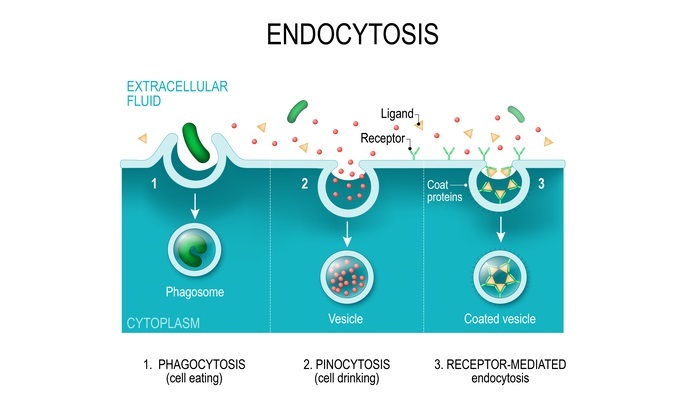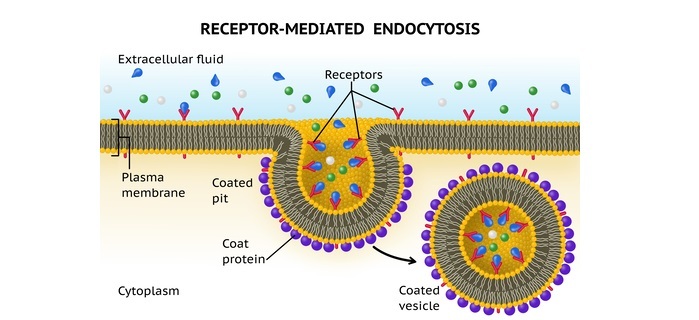
 Data Structure
Data Structure Networking
Networking RDBMS
RDBMS Operating System
Operating System Java
Java MS Excel
MS Excel iOS
iOS HTML
HTML CSS
CSS Android
Android Python
Python C Programming
C Programming C++
C++ C#
C# MongoDB
MongoDB MySQL
MySQL Javascript
Javascript PHP
PHP
- Selected Reading
- UPSC IAS Exams Notes
- Developer's Best Practices
- Questions and Answers
- Effective Resume Writing
- HR Interview Questions
- Computer Glossary
- Who is Who
Receptor Mediated Endocytosis or Clathrin Mediated Endocytosis
Introduction
Receptor Mediated Endocytosis (RME) is a highly selective process that enables cells to internalize specific molecules, such as hormones, growth factors, and nutrients, by binding to specific cell-surface receptors. Endocytosis is the process by which cells internalize extracellular material by engulfing it in vesicles that form at the plasma membrane.
This process is critical for a variety of cellular functions, including nutrient uptake, receptor recycling, and cell signalling. There are several types of endocytosis, including phagocytosis, pinocytosis, and receptor-mediated endocytosis (RME), which is also known as clathrin-mediated endocytosis (CME).

In this tutorial, we will discuss the mechanism of RME and its importance in cellular physiology.
Mechanism of RME
RME involves the interaction of specific ligands with their corresponding receptors on the cell surface, which triggers the formation of clathrin-coated pits (CCPs).
Clathrin is a protein that assembles into a lattice-like structure around the invaginated vesicle, providing structural support for the formation of the vesicle.
The formation of CCPs is initiated by the binding of adaptin proteins to the cytoplasmic domain of the receptor.

Adaptins are a family of proteins that help to select cargo molecules and recruit clathrin to the site of endocytosis.
There are several types of adaptins, including AP-1, AP-2, and AP-3, which are involved in different types of endocytosis.
Once the adaptins have recruited clathrin to the membrane, the clathrin molecules assemble into a basket-like structure around the invaginated vesicle.
The clathrin-coated vesicle then buds off from the plasma membrane, forming an uncoated vesicle in the cytoplasm.
The uncoated vesicle then fuses with early endosomes, where the cargo molecules are sorted and transported to their final destinations. Cargo molecules can be internalized by RME in several ways.
-
Some receptors, such as the LDL receptor, bind to their ligands directly, while others require the assistance of co-receptors or accessory proteins.
For example, the transferrin receptor requires the co-receptor CD71 to facilitate its internalization.
Once internalized, the cargo molecules are sorted in the early endosome based on their destination. For example, some molecules are recycled back to the plasma membrane, while others are transported to lysosomes for degradation.
Importance of RME
RME is a critical process in cellular physiology, as it allows cells to internalize specific molecules from the extracellular environment. This process is important for a variety of cellular functions, including nutrient uptake, receptor recycling, and cell signaling.
For example, the LDL receptor is critical for the uptake of cholesterol into cells.
Defects in the LDL receptor result in a condition called familial hypercholesterolemia, which is characterized by high levels of LDL cholesterol in the blood and an increased risk of cardiovascular disease.
In addition to nutrient uptake, RME is also important for the recycling of cell-surface receptors. Receptor recycling allows cells to regulate the levels of specific receptors on the plasma membrane, which is critical for maintaining cellular homeostasis.
For example, the epidermal growth factor receptor (EGFR) is a cell-surface receptor that is internalized by RME.
Once internalized, the receptor is either recycled back to the plasma membrane or transported to lysosomes for degradation.
This process allows cells to control the levels of EGFR on the plasma membrane, which is important for regulating cell growth and differentiation.
Finally, RME is also important for cell signalling. Many signalling molecules, such as hormones and growth factors, bind to cell-surface receptors and initiate a signalling cascade within the cell. The internalization of these receptors by RME is an important step in regulating the duration and intensity of the signalling response.
For example, the insulin receptor is internalized by RME, which helps to regulate insulin signalling in cells.
Defects in insulin signalling are associated with several metabolic disorders, including diabetes.
Regulation of RME
The process of RME is tightly regulated by several mechanisms to ensure that it occurs only when necessary. One of the key regulatory mechanisms is the phosphorylation of receptor tyrosine kinases (RTKs) and adaptin proteins.
RTKs are a family of cell-surface receptors that are activated by ligand binding and initiate a signalling cascade within the cell. The phosphorylation of RTKs and adaptin proteins by specific kinases, such as c-Src and Fyn, can either enhance or inhibit the internalization of receptors by RME.
Another regulatory mechanism involves the ubiquitination of cell-surface receptors. Ubiquitination is a post-translational modification that involves the attachment of ubiquitin molecules to proteins.
The ubiquitination of cell-surface receptors by E3 ubiquitin ligases, such as Cbl and Nedd4, targets the receptors for internalization by RME. The level of ubiquitination can also determine the fate of the receptor, with highly ubiquitinated receptors being targeted for degradation in lysosomes.
The lipid composition of the plasma membrane can also regulate RME. The level of cholesterol in the plasma membrane can affect the clustering and internalization of some receptors, such as the LDL receptor.
In addition, the level of phosphatidylinositol 4,5-bisphosphate (PIP2) in the plasma membrane can also affect the internalization of receptors by RME. PIP2 is a phospholipid that plays a key role in the formation of CCPs, and depletion of PIP2 can inhibit RME.
What Can We Interpret
Receptor-mediated endocytosis (RME), also known as clathrin-mediated endocytosis (CME), is a highly selective process that allows cells to internalize specific molecules from the extracellular environment. This process is critical for a variety of cellular functions, including nutrient uptake, receptor recycling, and cell signalling.
Receptor-mediated endocytosis (RME) has several clinical applications, ranging from drug delivery to cancer therapy. The selective nature of RME allows for the targeted delivery of drugs and other molecules to specific cells, which can increase the efficacy of the treatment and minimize side effects.
Hence it is never wrong to say RME would find its significance in the field of medicine and gene therapy for years to come.

